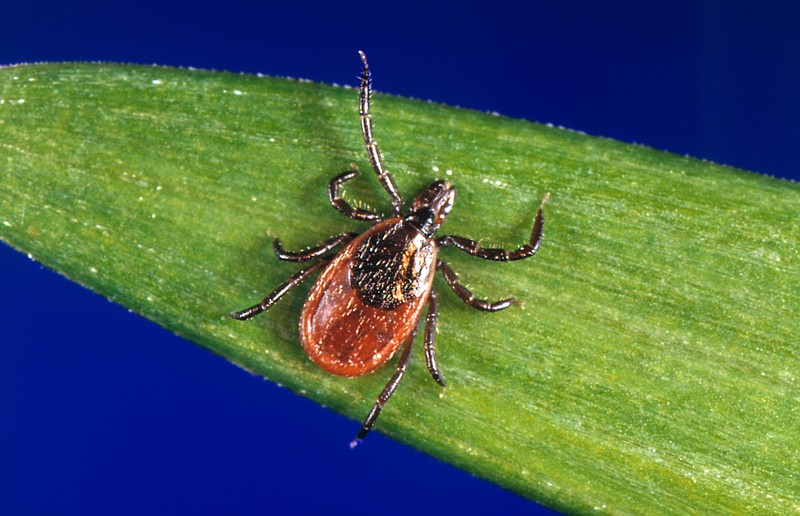The coming of the fall and winter seasons have many people concerned about colds, flu or other seasonal ailments. Yes, all of those can be of concern. Taking precautions is a good idea.
But, don't forget that it is tick season. In fact, it is pretty much always tick season. Yes, even in the winter. So, when taking precautions against tick diseases, don't ever let up.
While I am not an expert on ticks, or tick diseases, after having had both Rocky Mountain spotted fever and ehrlichiosis in the last four years, I've learned as much as possible about them. I also take extra precautions.
To begin with, there are two basic groups of ticks - hard bodied and soft bodied. Diseases can be passed on by both.
Most ticks take a hiatus during the winter, but others take up the slack and begin their usual blood-sucking activity in the fall. They generally carry on with it until spring, as long as the temperature stays near or slightly above freezing. Apparently, they only take a rest when the other ticks are ready to take up the job again.
In other words, don't be fooled into thinking you are safe from ticks, just because it is cold outside. There are some ticks that will start looking for an unwilling host on a sunny day of 15 degrees above zero, while you are crunching through snow on the ground.
Until the hungry tick finds a suitable victim, it hunkers down under snow and ice in leaves, grass or other vegetation. Sometimes they will seek shelter from the cold in a tree. So beware.
Now that you know that ticks may be anywhere at anytime, how about some more unpleasant information?
According to "Tickborne Diseases of the United States - A Reference Manual for Health Care Providers, Third Edition, 2015, CDC," ticks are responsible for more human disease than any other insect. They are also effective at transmitting an infectious disease between animals and humans. In fact, they are very effective at this, since what they do is suck blood from just about any living thing, small and large mammals, reptiles and birds.
The ticks do this because, for the most part, they must have a "blood meal" before they are able to molt, and go into the next stage of the tick's life cycle. A tick becomes infected with what ever disease-causing organism is infecting the animal it takes blood from.
According to the health department, at least six different human tick-borne diseases have been reported in Missouri. They are Rocky Mountain spotted fever, ehrlichiosis, tularemia, Q-fever, Lyme or a lyme-like disease, and the southern tick-associated rash illness. The number of tick-borne illnesses in Missouri increased to 668 in 2008, nearly 100 more cases than the previous year. And the ticks and victims of the diseases they transmit continue to rise.
Even the infections they transmit have increased. One new disease is Bourbon Fever, which is not as much fun as some people might think from the name. It is actually named after the county in Kansas where the disease was first identified in 2014. Bourbon Fever is a virus, and quite often fatal. A woman from Sullivan, who died in June, after testing by CDC, was found in July to have died from Bourbon Fever.
There is yet another tick-related problem; a really serious problem for those of us who like our steaks. It's really an allergy, rather than an disease. But it still is tick-bite related. This allergy can be caused by the bite of the lone star tick. According to the researchers, the tick injects a sugar known as alpha-gal during the bite. Some people have an immune response to the substance and create an antibody. The person could go into anaphalactic shock just from having a bite of a juicy steak. Actually, it can be from any mammal meat.
I suppose for those who prefer fish, chicken or turkey, this isn't so much of a problem. But for those who live for barbecued beef or ribs, this could be life-changing to say the least.
The problem of meat allergy has been increasing over the years, and is apparently spreading. There were only a few cases known just a few years ago, even though it has been a worldwide problem. In the United States, it is spread by the bite of the lone star tick. In Europe, it is the European castor bean tick. In Australia it is the paralysis tick. According to one source, Alpha-gal is even present in some substances used for medical treatment such as an anti-cancer drug and a couple of IV fluid replacements.
How do we prevent being bitten by a tick? For one, always walk in the center of trails. Avoid overhanging limbs, branches and tall grass. Ticks often perch on stems of grass, low brush, and even on leaf edges on the ground. Ticks do not jump or fly and usually stay no more than three feet above the ground.
Use an insect repellent, which has DEET, on your skin, or permethrin on clothing. Wear boots.
It might be advisable to go a step further. One outdoorsman said that if he is going to be in the field, he actually duct-tapes his pant legs to his boots and makes certain there are no loose seams. He commented that it may look funny to others, but he does his best to avoid ticks, while still maintaining an outdoor life.
If you get a tick, remove it as soon as possible, and as safely as possible.
To my fellow tick-magnets, remember to beware and be aware. Look out for ticks, because they are certainly out there looking for you.

